Skin Cancer: A Crucial Conversation in the Cosmetology Industry
Skin cancer ranks as one of the most prevalent forms of cancer, with nearly 3.5 million diagnoses each year. Despite its high prevalence, there’s a marked complacency and lack of knowledge about prevention, early detection, and the real risks associated with skin cancer, particularly among younger populations. Given their hands-on work with clients’ skin, cosmetologists can play a vital role in recognizing early signs of potential skin cancer and advising clients to seek medical attention. This article delves into the essential knowledge and best practices for cosmetologists in the fight against skin cancer.

Skin Cancer
The Urgency of the Issue
Skin cancer doesn’t discriminate — it can occur in people of all ages, even those who are otherwise in good health. Contrary to common misconception, youth is not an absolute safeguard against skin cancer, and neither is an overall healthy lifestyle. The significant impact and increasing prevalence of skin cancer make it a critical issue in the field of cosmetology.
Recognizing Skin Cancer
Skin cancer often manifests as a new growth or an alteration in the appearance of existing moles, freckles, or birthmarks. The key warning signs include asymmetry, irregular borders, varied coloration, a diameter larger than a pencil eraser, and evolution or change over time — commonly remembered by the acronym ABCDE.
While cosmetologists aren’t medical professionals, their familiarity with clients’ skin and regular close-up interactions can put them in a unique position to spot changes that may go unnoticed by the clients themselves.
Benign (harmless) and Malignant (cancerous) Skin Lesions | |
Lesions | Description |
Benign mole | Small spot on the skin ranging in color from pale tan to brown or bluish black Note: This is not a type of skin cancer. |
Basal cell carcinoma | Most common and least severe skin cancer; characterized by light or pearly nodules; has an 85% to 95% recurrence-free rate with early diagnosis and treatment |
Squamous cell carcinoma | More serious than basal cell carcinoma; characterized by scaly red or pink papules or nodules; also appear as open sores or crusty areas; can spread to other parts of the body; survival rates depend on the stage at diagnosis |
Malignant melanoma | Least common, but most dangerous form of skin cancer; characterized by black or dark brown patches on the skin that may appear uneven in texture, jagged, or raised; 100% fatal if left untreated; early detection and treatment may result in a 99% five-year survival rate for the localized stage, but that drops drastically (66%) once it reaches local lymph nodes |
Benign (harmless) and Malignant (cancerous) Skin Lesions
Professional Responsibility
The role of a cosmetologist extends beyond enhancing clients’ appearance — it’s also about ensuring their health and well-being. If a cosmetologist identifies a suspicious skin change, it’s their responsibility to guide their client to seek medical attention. Such proactive measures could potentially save lives by facilitating early detection and treatment of skin cancer.
However, cosmetologists should remember their professional boundaries and avoid diagnosing or providing medical advice. The appropriate response upon spotting a suspicious skin change is not to diagnose but to recommend a client see a physician for further investigation.
Raising Awareness
Cosmetologists can also play a role in promoting skin cancer awareness. This can involve educating clients about the importance of regular skin self-examinations, the correct use of sun protection, and the necessity of regular dermatological checks.
Knowledge is power in the fight against skin cancer, and cosmetologists, as trusted professionals, can make a significant difference by spreading the word about prevention and early detection strategies.
In conclusion, cosmetologists have a crucial part to play in combating skin cancer. While they can’t replace medical professionals, their contributions in spotting early signs and promoting skin health awareness could prove pivotal in the early detection and successful treatment of skin cancer. Remember, it’s better to err on the side of caution when someone’s health — and potentially their life — is at stake.











